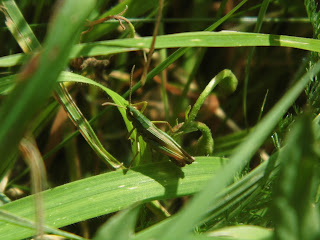29th August 2016
Cathy & I had wanted to take our mothers on a trip to Hoveton Hall gardens for a while, however they are only open for a limited time in early summer and then on special open days. On bank holiday Monday there was one of these open days to raise money for Age UK, so we took the opportunity to have a look around.
We started in two of the 'cottage garden' type areas, the spider garden and the walled garden. Whilst having a look at the plants I was mainly looking for insects, and we spotted a number of interesting ones. Amongst the bees and hoverflies was a Hornet, and there were both Hairy and Woundwort Shieldbugs. A well camouflaged Common Groundhopper was found on some bare ground near Yellow Sorrel, and there was also an interesting bee for me to try to identify.
We then went into the water garden, where we could hear the clicking of hundreds of Rhododendron leafhoppers landing and jumping from the vegetation. Further round we could hear Bullfinches and a Great-spotted Woodpecker. Whilst Cathy, Sue and Margaret sat down, I wandered about looking for hoverflies, finding a large Sericomyia silentis.
From here we headed back for lunch in a courtyard. We sat underneath a shelter, and soon noticed that there was an active Swallow nest in the corner. We were treated to repeated flights from the adults, whizzing just over our heads and soaring up at the last minute onto the nest to feed the young.
After lunch we headed down to the lake and then into the woods. Stopping near the lake we saw an ovipositing Brown Hawker, but of more interest was a pair of Willow Emerald damselflies laying eggs into Rhododendron stems. This species has only been seen in Norfolk in the past ten years, and as Rhododendrons don't occur near the water at many (any?) other current sites, this may be a new host for Norfolk unless others have also observed this.
Another interesting sighting was a sawfly larva on Yellow Loosestrife, whilst there were more hoverflies in the woods near St Peter's church. We headed across a sheep field back to the car park, and called in at the church on our way back to have a look round.


















































